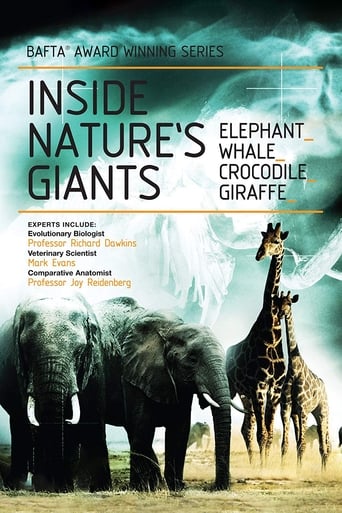
Watch Inside Nature's Giants (2009) Online!
Inside Nature's Giants is a British science documentary, first broadcast in June 2009 by Channel 4. The documentary shows experts performing dissection on some of nature's largest animals, including whales and elephants. The programme is presented by Mark Evans. The series attempts to uncover the secrets of the animals examined. Mark is assisted by evolutionary biologists Richard Dawkins and Simon Watt, and comparative anatomist Joy Reidenberg. The show is currently airing on PBS in the United States and repeats are currently airing on Eden and Watch in the UK. There is an iPad application that allows you to see every animal the show have worked on close up.
-

Episode 1 - The Elephant
Release Date: 2009-06-29This programme looks at how evolution has overcome the challenges of being as big as an elephant. Elephants feed on plants with very little nutritional value for 18 hours a day, so evolution has given them vast intestines as well as huge teeth and jaw muscles - and an equally gigantic head. But this produces another problem: how to reach food on the ground. The solution is the most versatile limb on the planet - the trunk. Capable of everything from picking up berries to ripping a tree from the ground, the trunk is a wonder of evolution. It's a Just So Story for the Darwinian age.
-

Episode 2 - The Whale
Release Date: 2009-07-06In this episode experts dissect a 65-foot, 60-ton fin whale - second only in size to its 'cousin' the blue whale - that has died after being stranded off the coast of Ireland. It's a race against time as whale anatomist Joy Reidenberg flies in from New York before the animal's decomposition causes it to explode on the beach. Veterinary scientist Mark Evans helps investigate why the animal died and explores its extraordinary anatomy. Using whale-size machinery, Joy and the team set to work amidst gale force winds, driving rain, blood, intestines, evil smells and freezing conditions. Meanwhile, advancing tides threaten to engulf the whale, as the team struggles to complete the operation. Beneath the blubber, the whale's unique anatomy holds vital clues to its evolution. Using a combination of dissection and computer graphics, the programme discovers an animal whose closest living relative is the hippo. Meanwhile, evolutionary biologist Richard Dawkins explains why the whale's ancestors may have taken to the water and the evolutionary problems that had to be overcome to transform a land-based mammal into an animal that swims among fish.
-

Episode 3 - The Crocodile
Release Date: 2009-07-13Veterinary scientist Mark Evans joins experts in anatomy, evolution and behaviour in a bid to get under the skin of the crocodile. Meanwhile evolutionary biologist Professor Richard Dawkins explains how little the crocodile has changed since the age of the dinosaurs. The team uncovers the crocodile's incredible jaw muscles, as biologist Simon Watt travels to Florida to test the huge strength of the massive reptile's bite: the most powerful in the animal kingdom. But while crocodiles' spiked teeth are excellent for gripping prey as they plunge into a death roll, they are useless for chewing. So how do these animals manage to digest large chunks of raw meat and bone? As the experts dissect the digestive system and inspect the stomach contents for clues, they reveal the bizarre plumbing between the heart and the stomach that might provide the key to this puzzle. And they also solve the mystery of this crocodile's premature death.
-

Episode 4 - The Giraffe
Release Date: 2009-07-20Veterinary scientist Mark Evans acts as guide as a team of experts investigate the giraffe. Creationists question how this extraordinary creature could have evolved such a long neck, but for evolutionary biologist Professor Richard Dawkins the anatomy of the world's tallest animal provides some of the best arguments in favour of Darwinian natural selection. For example, one nerve takes a huge detour up and down the long neck, from the voice box to the brain, via the chest - hardly the work of an `Intelligent Designer'. And, despite its length, the neck still only has seven vertebrae - the same number as almost all mammals, from mice to humans and whales. But it's no wonder the giraffe has the highest blood pressure of any animal; with a heart not much bigger than our own it must pump blood at high pressure around a towering body. It has evolved thick skin that acts as a natural 'G-suit' and a complex circulation system to avoid passing out when raising and lowering its head. And as the dissection team piece together the remarkable evolutionary story of the giraffe, biologist Simon Watt observes them in the field as they eat, forage and fight.
